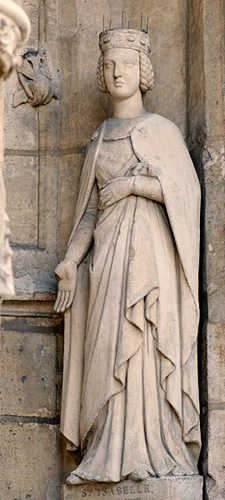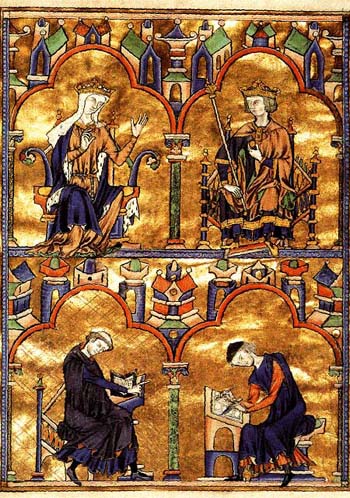 |
The Saint of the Day
St. Isabelle of France – February 26
Prof. Plinio Corrêa de Oliveira
Biographical selection:

St. Isabelle of France
|
The daughter of King Louis VIII and Queen Blanche of Castile, Isabelle was born in 1225. At less than two years of age, she lost her father, but her mother gave her a complete formation, assisted by the virtuous and well-educated Lady de Boisemont. From an early age, Isabelle showed an aversion for everything that could remove her from God, and later decided to dedicate her life to His service.
St. Louis IX, her brother, and her mother Blanche of Castile pressed her to marry Conrad, the son of the Emperor Frederic II because the union would be advantageous to France, but Isabelle adamantly refused. A letter from Pope Innocent IV settled the matter: he commended her resolution and advised her to persevere in her decision.
Thenceforth, she began to live in the royal castle a life similar to that of a religious in a cloister, dedicating herself principally to helping the sick and the poor. God sent her many trials: long and grave illnesses, the death of her mother, her brother’s failure in the Crusade and his imprisonment by the Arabs. After he was freed from captivity and had returned, Isabelle left the royal castle and founded a Franciscan house for young women in Longchamp. Later she founded the Convent of the Humility of the Blessed Virgin, of which she became the Abbess.
As Abbess, St. Isabelle suffered from constant illness. She was also favored by mystical graces and ecstasies. In one of these revelations, she was given to know the day and hour she would pass away. She died on February 25, 1270. In accordance with her will, she was buried wearing the habit of St. Clare in the Convent she had founded. She was beatified on January 3, 1521 by Pope Leo X.
Comments of Prof. Plinio:
In this life we find more data to negate the lie constantly spread about the royal courts. According to it, they would be dens of pleasure, sensuality, and pride; a place where virtue had no place. In the court of France at that time, however, we have two saints: one is on the throne and the other is his sister, very near to the throne. Both were giving God the greatest possible glory. There was also Blanche of Castile, their mother, who, although she is not a saint, was a most worthy woman noted for her austerity, authority, and many moral qualities.

Blanche of Castile and St. Louis at the royal court of France: An ambience that favored sanctity
|
The life of St. Isabelle of France teaches us that God gives His saints something quite different from the American happy ending. Here you find a Princess who abandoned everything to dedicate her life to the care of the poor and to prayer. Indirectly we glean from this selection that she carried a part of her brother’s cross, suffering and praying for him when he was imprisoned. She also prayed for the great deeds of the Catholic cause, the Crusades. She suffered profoundly at the failure of St. Louis’ Crusade.
She was living the life of a religious in the royal palace, but when the King came back, she left the court to found a Franciscan institution of charity. Although she was sick all her life, she conquered this obstacle and transformed it into a means for her sanctification.
We see how erroneous the thinking is that imagines everything in the apostolate has to run well and end happily. This is a naturalist spirit, falsely influenced by the happy ending of the movies. Divine Providence put many obstacles in the path of St. Isabelle for her to achieve sanctification, and she conquered each one.
The name of the convent she founded is very beautiful: the Convent of the Humility of the Blessed Virgin. It gives the impression that a mantle of humility covers the entire convent and that the humility of Our Lady is present everywhere. It seems to be a foretaste of Heaven.
It is delightful to see how God glorifies His saints. There is a prayer of Our Lord in the Gospel in which He asks the Eternal Father to glorify Him. God did glorify Him; He also glorifies His saints.
We see this in her life when He revealed to St. Isabelle of France the day and hour she would leave this world. As a reward for her fidelity, she was given to know when she would die. She was longing to be in Heaven, as a bride awaiting her groom, so God told her the exact time. Her death was a glorification, a confirmation of her sanctity.


  | |
Prof. Plinio Corrêa de Oliveira | |
The Saint of the Day features highlights from the lives of saints based on comments made by the late Prof. Plinio Corrêa de Oliveira. Following the example of St. John Bosco who used to make similar talks for the boys of his College, each evening it was Prof. Plinio’s custom to make a short commentary on the lives of the next day’s saint in a meeting for youth in order to encourage them in the practice of virtue and love for the Catholic Church. TIA thought that its readers could profit from these valuable commentaries.
The texts of both the biographical data and the comments come from personal notes taken by Atila S. Guimarães from 1964 to 1995. Given the fact that the source is a personal notebook, it is possible that at times the biographic notes transcribed here will not rigorously follow the original text read by Prof. Plinio. The commentaries have also been adapted and translated for TIA’s site.
|
Saint of the Day | Home | Books | CDs | Search | Contact Us | Donate

© 2002- Tradition in Action, Inc. All Rights Reserved
|
 |
|